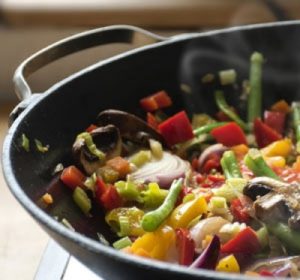5 Often-Neglected Cooking Methods to Keep Nutrients Intact

 By now, we know that sauces and spices are not the only ways to make a dish taste phenomenal. How we cook our meals also matters, whether we choose to hit the grill or sizzle those veggies with heart-healthy olive oil. But, what we don't know (or often neglect) is that certain cooking methods tend to strip some of our favorite foods from their nutrients, negating the whole point of eating them.
By now, we know that sauces and spices are not the only ways to make a dish taste phenomenal. How we cook our meals also matters, whether we choose to hit the grill or sizzle those veggies with heart-healthy olive oil. But, what we don't know (or often neglect) is that certain cooking methods tend to strip some of our favorite foods from their nutrients, negating the whole point of eating them.Luckily, there are a lot of ways to get past this issue and still enjoy a delicious meal. From steaming to sautéing, these are five surefire cooking methods to keep nutrients intact and get the most out of your meals, not just on a nutritional level but also taste-wise.
1. Steaming
It's true; steamed foods don't always taste that good. However, research(1) suggests that this cooking method may be a solid way to keep nutrients intact. How come? By creating a water-dominant environment, steaming "traps" the food's moisture, forcing it to cook in its own juices. As a result, nutrients have no way but to remain inside the food throughout the process – most of them, at least. It's as simple as that.
The only issue with steaming is that foods usually taste bland, urging us to instinctively reach for that butter or salt. However, if you want to avoid adding unnecessary calories to the mix, make sure you season the foods beforehand, whether that's a few drops of lemon juice or a pinch of salt.
2. Roasting
Oven-roasted meat is probably no news to you. However, your roasting potential doesn't end there. Veggies are now in on the action and have slowly become the latest obsession among health-conscious eaters. But, did you know that besides making vegetables taste that much better, this cooking method is also a great way to retain most of your meals' nutrients?
Experts(2) report that roasting helps retain up to 75% of B vitamins in root and leafy green vegetables. So, next time you are thinking of scalding your beets or yams, cut them up and toss them in the oven. It's totally worth it!
PS: Some nutritionists claim that roasted foods inevitably increase the production of oxidative AGEs(3) (Advanced Glycation End-products) throughout your body. Note, though, that the human body produces more AGEs on its own than it could ever receive through foods. So, at the end of the day, you have nothing to worry about.
3. Sautéing (with Olive Oil)
Touché: Sautéing doesn't sound like the healthiest way to cook food. But, it turns out that this method is not as "bad" as we thought. According to one recent study(4), cooking foods (vegetables, in particular) in a little bit of olive oil increases their antioxidant capacity, turning them into nutritional mega-bombs.
Specifically, the study shows that the foods cooked in olive oil ended up containing more phenols than when they were raw. Of course, that doesn't mean that you should soak your veggies in olive oil every time you cook. In this case, a little goes a long way.
4. Boiling
For many, boiling is the go-to cooking method, especially when the time is scarce. But, as innocent as it seems, this approach usually breaks down a large number of nutrients, with vegetables being the most susceptible food group.
That occurs because high temperatures cause the nutrients to loosen their bonds, dissolve and become one with the surrounding environment, a.k.a. boiling water. So, when you are done cooking your food and get rid of the water, you basically dispose of a large percentage of those nutrients.
But, if that's the case, why is boiling one of the best ways to keep nutrients intact? Here's the deal. While this method is a big no-no for water-soluble vitamins and minerals, it increases the bioavailability of nutrients such as lycopene(5) and beta-carotene. The bottom line? Your boiling streak should be limited to carrots(6) and tomatoes.
5. Microwaving
That may come as a total surprise to you, but according to experts(7), microwaving your food may be the easiest way to keep nutrients intact, especially when it comes to veggies. You see, water-soluble nutrients such as vitamin C (present in broccoli, cauliflower, bell peppers, etc.) break down in no time when exposed to heat.
Unlike other cooking methods, microwaving is capable of prepping your food in a short amount of time and at low temps. That means that the nutrients don't have enough time to dissolve, so the majority of them remains intact.
On top of that, microwaving is by nature against the use of added liquids such as oils. So, you are kind of "forced" to consume fewer fats which takes you one step closer to your healthy eating goals. Despite all these, always remember to cook your foods in a microwave-safe container.
Also, Keep in Mind...
Chopping
Peeling
The Takeaway
Between steaming, microwaving and roasting, it's obvious that there are a lot of ways to get the most out of your meals. But, never forget that a balanced diet is not a matter of how you cook your food, but rather how many vegetables you include in it on a day-to-day basis. The moral of the story? Keep these cooking methods close, but your veggies (and their nutrients) closer.
References:
- https://www.ncbi.nlm.nih.gov/pmc/articles/PMC2722699/
- https://www.ncbi.nlm.nih.gov/pubmed/18421876
- https://www.ncbi.nlm.nih.gov/pmc/articles/PMC3704564/
- https://www.sciencedirect.com/science/article/pii/S0308814615006810
- https://www.ncbi.nlm.nih.gov/pubmed/11192026
- https://pubs.acs.org/doi/abs/10.1021/jf9910178?prevSearch=S.T.+Talcott&searchHistoryKey=
- https://www.health.harvard.edu/staying-healthy/microwave-cooking-and-nutrition
- https://ods.od.nih.gov/pdf/factsheets/VitaminC-Consumer.pdf
- admin
